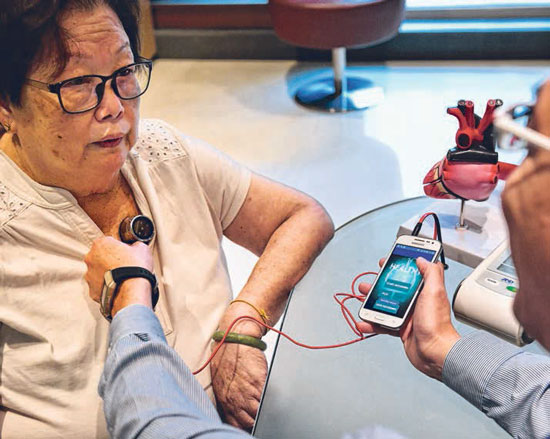It checks the cause of breathlessness and helps cut down on hospital admissions
The Straits Times (30 October 2018) - Heart failure patient Tan Hui Keng, 71, needs to go to a hospital emergency ward whenever she starts getting breathless. This happens about two times a year. Soon, a home-use device may be able to tell patients like Madam Tan very early whether their breathlessness is being brought on by potential heart failure or some other medical condition.

Tan Tock Seng Hospital’s head of cardiology David Foo demonstrating the use of the device
– which checks for fluid accumulation in the lungs, an early symptom of heart failure
– to heart patient Tan Hui Keng at the hospital yesterday. The device was developed
by a team from Nanyang Technological University and the hospital.
ST PHOTO: KUA CHEE SIONG
The device checks for fluid accumulation in the lungs, which causes breathlessness, and is one of the early symptoms of heart failure. It was developed by a team from Nanyang Technological University (NTU) and Tan Tock Seng Hospital (TTSH), which showcased the prototype yesterday.
All that patients have to do is to place a small sensor on their chest or back. This picks up sounds from their lungs and sends the sound signals through a mobile app to a server in the cloud. The server has an artificial intelligence algorithm that determines if the patient’s lungs are clear or whether fluid is accumulating inside them.
The entire process takes a mere 10 seconds, said Associate Professor Ser Wee of NTU’s School of Electrical and Electronic Engineering. Associate Professor David Foo, who is head of cardiology at TTSH, said the device can help to cut down on hospital admissions.
The current methods to detect fluid accumulation in the lungs either involve doctors using a stethoscope to listen to the patient’s breathing – which can be subjective – or chest X-rays or CT scans, which are costly and time-consuming, he added.
Prof Foo estimates that the device stands to benefit between 30 per cent and 40 per cent of the around 5,000 patients admitted to hospitals here for heart failure every year.
Ten years in the making, the device has been shown to have a more than 92 per cent accuracy rate in identifying patients who have fluid accumulation in their lungs, based on a study of 86 TTSH patients from 2012 to 2015. This is comparable to existing gold-standard diagnosis methods such as X-rays and CT scans. The next step is to conduct a larger-scale study on around 300 TTSH patients, starting next month or early next year, said Prof Ser.
The team has filed a patent for the device. It has also been approached by a major pharmaceutical company as well as multinational and local healthcare companies for possible collaborations. Prof Ser said the device could cost patients between $100 and $200. Another device that also monitors fluid accumulation in the lungs, but which uses resistance to electrical current, is being trialled by Israel-based company RS Medical Monitoring.
Lungs which contain a build-up of fluid are less resistant to electrical current than lungs which are healthy.
However, Prof Ser said that this method is less exact than the team’s algorithm because the resistance to electrical current can also depend on other factors such as blood density and concentration, as well as tissue.